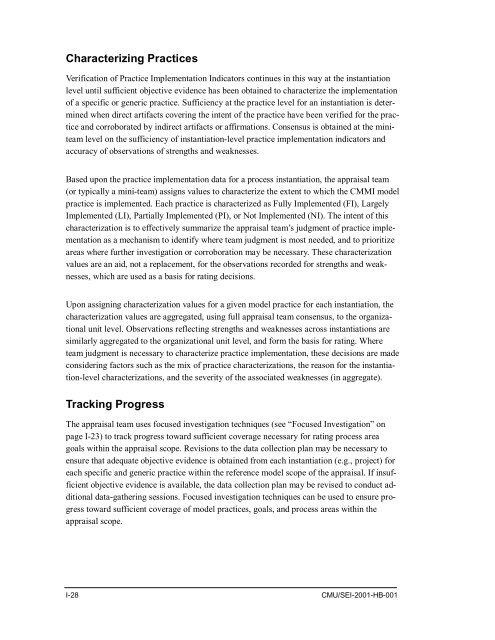Standard CMMI Appraisal Method for Process Improvement (SCAMPI)
Standard CMMI Appraisal Method for Process Improvement (SCAMPI)
Standard CMMI Appraisal Method for Process Improvement (SCAMPI)
You also want an ePaper? Increase the reach of your titles
YUMPU automatically turns print PDFs into web optimized ePapers that Google loves.
Characterizing Practices<br />
Verification of Practice Implementation Indicators continues in this way at the instantiation<br />
level until sufficient objective evidence has been obtained to characterize the implementation<br />
of a specific or generic practice. Sufficiency at the practice level <strong>for</strong> an instantiation is determined<br />
when direct artifacts covering the intent of the practice have been verified <strong>for</strong> the practice<br />
and corroborated by indirect artifacts or affirmations. Consensus is obtained at the miniteam<br />
level on the sufficiency of instantiation-level practice implementation indicators and<br />
accuracy of observations of strengths and weaknesses.<br />
Based upon the practice implementation data <strong>for</strong> a process instantiation, the appraisal team<br />
(or typically a mini-team) assigns values to characterize the extent to which the <strong>CMMI</strong> model<br />
practice is implemented. Each practice is characterized as Fully Implemented (FI), Largely<br />
Implemented (LI), Partially Implemented (PI), or Not Implemented (NI). The intent of this<br />
characterization is to effectively summarize the appraisal team’s judgment of practice implementation<br />
as a mechanism to identify where team judgment is most needed, and to prioritize<br />
areas where further investigation or corroboration may be necessary. These characterization<br />
values are an aid, not a replacement, <strong>for</strong> the observations recorded <strong>for</strong> strengths and weaknesses,<br />
which are used as a basis <strong>for</strong> rating decisions.<br />
Upon assigning characterization values <strong>for</strong> a given model practice <strong>for</strong> each instantiation, the<br />
characterization values are aggregated, using full appraisal team consensus, to the organizational<br />
unit level. Observations reflecting strengths and weaknesses across instantiations are<br />
similarly aggregated to the organizational unit level, and <strong>for</strong>m the basis <strong>for</strong> rating. Where<br />
team judgment is necessary to characterize practice implementation, these decisions are made<br />
considering factors such as the mix of practice characterizations, the reason <strong>for</strong> the instantiation-level<br />
characterizations, and the severity of the associated weaknesses (in aggregate).<br />
Tracking Progress<br />
The appraisal team uses focused investigation techniques (see “Focused Investigation” on<br />
page I-23) to track progress toward sufficient coverage necessary <strong>for</strong> rating process area<br />
goals within the appraisal scope. Revisions to the data collection plan may be necessary to<br />
ensure that adequate objective evidence is obtained from each instantiation (e.g., project) <strong>for</strong><br />
each specific and generic practice within the reference model scope of the appraisal. If insufficient<br />
objective evidence is available, the data collection plan may be revised to conduct additional<br />
data-gathering sessions. Focused investigation techniques can be used to ensure progress<br />
toward sufficient coverage of model practices, goals, and process areas within the<br />
appraisal scope.<br />
I-28 CMU/SEI-2001-HB-001
















